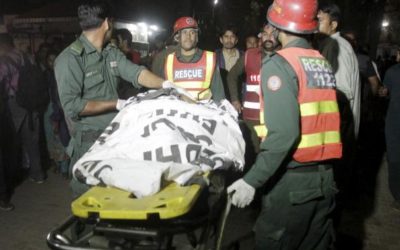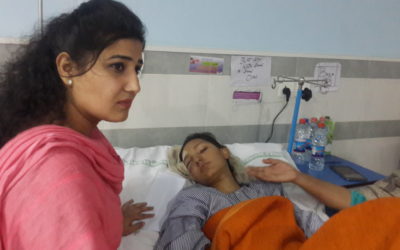The news agency Dawn recently published an article drawing attention to Pakistan’s meager health care system. Aptly titled “My 10 Days of Hell at a Lahore Hospital,” the middle-class author describes the miserable treatment, or rather lack thereof, given to her epileptic sister. She had been admitted to a Lahore Hospital while experiencing seizures in two-minute intervals. During the entirety of her 10-day stay, she was unable to see a neurologist who could properly assess her needs. When a junior doctor, at last, recommended an MRI, even the mere diagnostic procedure was complicated by a lack of stretchers.
Such was the extent of treatment given to a middle-class patient who could actually afford an MRI. Though upper-class Pakistanis can access good healthcare at private hospitals, the majority of Pakistanis, even middle-class Pakistanis who can afford the few treatment options available, have little or no access to even tertiary care because of extremely low public health spending, lack of doctors, and widespread poverty.
The state of Pakistani hospitals belies the lack of public health spending. In a recent ranking of Pakistani hospitals, the top 20 include only 4 public government hospitals. The best government hospital of those four, Pakistan Institute of Medical Science (Pims), ranks only 5,911 in the world. Pims has applied multiple times for an air-conditioning unit, which remains an unfulfilled request. It also lacks its own incinerator for hospital waste, and these are only basic facility requirements. Comparatively, the best private hospital in Pakistan ranks 1,842 in the world. Though Prime Minister Nawaz Sharif implemented a plan to provide free public healthcare this January, it seems to have been making little headway.
Even if Pakistan had quality facilities and enough of them, they would be severely understaffed. The majority of Pakistani medical students who go abroad to complete their studies don’t return. Data suggest there
Poverty only extends the vicious cycle of poor health. Low socioeconomic situations generate high-stress living conditions, which leads to a number of health issues. One doctor reports prescribing sedatives to 95% of his Lahore patients. In addition, poverty staves access to good healthcare and also decreases good health awareness in general. Some reports include those in extreme poverty selling their kidney to the rich out of desperation. Going into debt to pay for medical emergencies leads many into the vicious cycle of brick kiln enslavement, where the owners constantly change the amount owed and charge high interest.
Religious minorities also have great difficulty acquiring proper health care. Those whose Pakistani national identity cards denote their religion as other than Muslim are ineligible for receiving government aid. One minority who suffered multiple heart attacks for a year desperately needed quadruple bypass surgery to unblock his arteries. Though denied government aid, the supporters of RAM were able to cover the cost of his surgery. However, he still had to wait three months to book his surgery, during which he contracted malaria because others with higher connections and more money were given priority.
Achieving basic health care needs in Pakistan is extremely difficult if even a possibility for minorities, the lowest Untouchables, and those enslaved in brick kilns. Yet due to the work of RAM, the CosmoVision Center will be able to provide shelter to those rescued from enslavement and to address their immediate health care needs. To complete Phase II of the Center so it can begin helping these Pakistanis and those in their community, RAM must still raise $20,000.
In the U. S., we take it for granted that hospitals are often no more than 30 minutes away and that specialists are always on call. We visit a doctor for a mere sore throat and diagnostic procedures like MRIs are commonly affordable. But across the world, our brothers and sisters have never visited a doctor in their life. So here’s a challenge: are you willing to help make a difference in a Pakistani community? It could be the price of one co-pay, or it could be a commitment to help raise $1,000. However much it is, know that the impact of saving lives can reach farther than anyone could have thought possible.
Image source: http://hir.harvard.edu/poverty-and-poor-health-in-pakistan/.
Pakistani women stayed in abusive marriages because Pakistan failed
This article was originally published in Dawn. You can read the full article here. When domestic abuse is discussed on TV and in drawing rooms, people often ask: why didn't she leave her violent husband? Dania endured violent beatings during her pregnancies. But...
Abram a Survivor of the Easter Suicide Bombing in Pakistan Needs Help!
Abram a Survivor of the Easter Suicide Bombing in Pakistan Needs Help!Abram, along with his four friends was present in the park at the time of the blast. A splinter faction of the Pakistani Taliban, Jamaat ul-Ahrar, claimed responsibility for the attack, which the...
Lahore Blast Victims-RAM Team Aids the Victims of the Blast
LAHORE BLAST VICTIMS-RAM TEAM AIDS THE VICTIMS OF THE BLASTOn the 27th of March, on Easter evening, Christians were attacked once again in Pakistan and this time terrorists attacked the innocent people in a public park—Gulshan-e-Iqbal Park, Lahore. They killed 74...




0 Comments